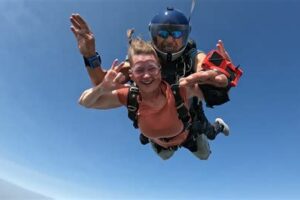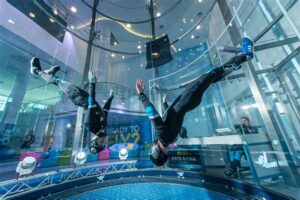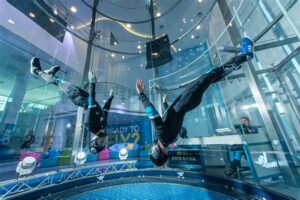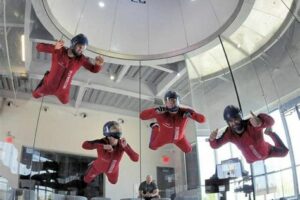Table of Contents
Curious about indoor skydiving? Discover how this thrilling sport works – from wind tunnel technology to body positioning techniques. Experience the sensation of freefalling without jumping out of a plane. Unleash your inner adrenaline junkie and defy gravity in a controlled and safe environment.
Indoor skydiving, also known as vertical wind tunnels, has taken the world of extreme sports by storm. With its intriguing concept and seemingly gravity-defying nature, it is no wonder that this thrilling activity has gained immense popularity in recent years. But have you ever wondered how indoor skydiving actually works? Prepare to be amazed as we delve into the mechanics behind this exhilarating experience.
Introduction
Indoor skydiving is an exhilarating and thrilling experience that allows individuals to simulate the sensation of freefalling in a controlled environment. It has gained popularity as an alternative to traditional outdoor skydiving, providing a safe and accessible way for people of all ages and abilities to enjoy the thrill of flight. But how does indoor skydiving work? Let’s dive into the details.
The Vertical Wind Tunnel
Creating the Perfect Environment
The key component of indoor skydiving is the vertical wind tunnel, also known as a indoor skydiving simulator. This impressive structure generates a powerful column of air that mimics the conditions experienced during outdoor skydiving. The wind tunnel consists of a large chamber with a high-powered fan at the top, which propels air down through the chamber at incredible speeds.
Controlling the Airflow
To simulate the sensation of freefall, the airflow in the wind tunnel needs to be carefully controlled. The fan at the top of the tunnel creates a vertical wind speed that ranges from 100 to 200 miles per hour. The airflow is evenly spread across the entire diameter of the tunnel, ensuring a consistent and smooth experience for the participants. Specialized grills and diffusers are used to modify the airflow and minimize turbulence.
The Flight Chamber
Stepping into the Chamber
Once inside the flight chamber, participants enter a cylindrical space lined with padded walls. The chamber is typically made of transparent materials, allowing spectators to observe the flight from outside. Safety nets and trained instructors ensure the well-being of the participants at all times.
Flying Techniques
Indoor skydiving requires specific flying techniques to maintain stability and control within the wind tunnel. Participants learn to adjust their body position to manipulate the airflow and achieve different types of movements. By extending or retracting their limbs, arching their back, or tilting their head, they can control their altitude and direction.
Safety Measures
Protective Gear
Just like in outdoor skydiving, safety is paramount in indoor skydiving. Participants are required to wear a jumpsuit made of durable material that protects their skin and clothes from the high-speed airflow. Additionally, a helmet, goggles, and earplugs are worn to ensure personal safety and comfort during the flight.
Professional Instructors
Indoor skydiving facilities are staffed with professional instructors who undergo extensive training to guide participants through their flight experience. These instructors have a deep understanding of the wind tunnel dynamics and flight techniques, ensuring the safety of all participants and providing personalized guidance to enhance their experience.
Accessibility and Benefits
For All Ages and Abilities
One of the significant advantages of indoor skydiving is its accessibility. Unlike outdoor skydiving, it doesn’t require perfect weather conditions, an airplane, or prior experience. People of all ages, including children and seniors, can enjoy the thrill of flight in a controlled and safe environment.
Physical and Mental Benefits
Engaging in indoor skydiving offers numerous physical and mental benefits. The intense wind resistance experienced during the flight strengthens core muscles, improves flexibility, and enhances body awareness. It also boosts confidence, reduces stress, and provides an adrenaline rush, leading to an overall sense of accomplishment and well-being.
Conclusion
Indoor skydiving is a remarkable adventure that has revolutionized the way people experience the sensation of freefall. By utilizing powerful vertical wind tunnels, controlling precise airflow, and employing trained instructors, individuals can enjoy the thrill of skydiving in a safe and accessible environment. Whether seeking an adrenaline rush or simply wanting to try something new, indoor skydiving offers an unforgettable experience for everyone.
Introduction
Indoor skydiving, also known as bodyflight, is a thrilling and adrenaline-pumping activity that simulates the experience of freefalling in a controlled environment. This modern sport has gained tremendous popularity in recent years, offering participants a safe and exhilarating adventure. In this article, we will explore the mechanics behind indoor skydiving and how it provides a unique and enjoyable experience for individuals of all ages and skill levels.
1. Wind Tunnel Technology
At the heart of indoor skydiving is wind tunnel technology. These vertical wind tunnels are powerful machines that generate a vertical column of air, providing the necessary lift and resistance for participants to experience the feeling of freefall. The wind tunnel’s powerful fans create an upward airflow that counteracts the force of gravity, allowing individuals to float and maneuver in mid-air with ease.
2. The Flight Chamber
The flight chamber is the central space within the wind tunnel where participants enter to experience the sensation of flying. Made of high-strength glass, the walls of the chamber ensure visibility while maintaining safety. The flight chamber is designed to be spacious, allowing individuals or groups to spread their limbs and control their movements as they soar through the air.
3. Airflow Control
Indoor skydiving facilities have precise control over the airflow within the wind tunnel. By adjusting the speed and direction of the air, instructors can create different levels of flight difficulty, catering to beginners or experienced flyers. This ability to control the airflow not only enhances the customized experience but also ensures the safety of the participants. The airflow stabilizes individuals, preventing unwanted movements or accidents.
4. Safety Measures
Safety is paramount in indoor skydiving centers. Before entering the wind tunnel, individuals receive comprehensive training and orientation from certified instructors. These professionals educate participants on proper body positions, hand signals, and basic flight techniques. Participants are also provided with safety equipment such as a jumpsuit, helmet, goggles, and earplugs to ensure their well-being during the flight.
5. Experienced Instructors
Indoor skydiving centers employ highly trained and experienced instructors who guide participants throughout the entire process. These professionals have extensive knowledge of bodyflight techniques and safety procedures. They offer individualized coaching, helping participants improve their skills as they progress. The presence of skilled instructors not only adds an extra layer of safety but also enhances the overall experience, ensuring participants achieve the highest level of enjoyment and achievement.
6. Aerial Acrobatics
Indoor skydiving is not limited to simulating freefall; it also provides the opportunity for participants to engage in thrilling aerial acrobatics. As individuals gain confidence and skill, they can attempt various maneuvers such as spins, flips, and turns within the wind tunnel. Some indoor skydiving centers even offer professional coaching and competitions, allowing enthusiasts to explore the world of competitive bodyflight.
7. Accessibility and Family-Friendly Activity
One of the major advantages of indoor skydiving is its accessibility. Unlike traditional skydiving, which requires extensive training, outdoor conditions, and the availability of aircraft, indoor skydiving can be enjoyed by people of all ages and skill levels. It is a family-friendly activity that provides a memorable experience for individuals, friends, and families, making it an ideal choice for special occasions, team-building events, or simply a thrilling day out.
8. The Future of Flight
Indoor skydiving has paved the way for advancements in human flight. As technology improves and wind tunnel design becomes more sophisticated, indoor skydiving is evolving into a training ground for professional skydivers and astronauts. The principles and skills learned in indoor skydiving can contribute to the development of future space programs and the exploration of the outer limits of our atmosphere. It serves as a testament to humanity’s unyielding passion for exploration and adventure, offering a glimpse into the future of flight.In conclusion, indoor skydiving provides an exhilarating and safe experience for participants of all ages and skill levels. Through the use of wind tunnel technology, precise airflow control, and the guidance of experienced instructors, individuals can simulate the sensation of freefall and engage in thrilling aerial acrobatics. This accessible and family-friendly activity not only offers a memorable adventure but also contributes to advancements in human flight and exploration. Indoor skydiving is a testament to our innate desire for adventure and serves as a gateway to the future of flight.
Indoor skydiving is an exhilarating and unique activity that simulates the thrilling experience of freefalling through the air. It provides individuals with the opportunity to experience the sensation of skydiving without the need for an actual airplane or parachute. This point of view will explore how indoor skydiving works, highlighting its technical aspects and the equipment involved.
1. Vertical Wind Tunnel: At the heart of indoor skydiving is a specially designed vertical wind tunnel. This structure consists of a powerful fan system that generates a controlled and upward-moving airflow. The wind tunnel is typically enclosed in a glass chamber, allowing spectators to observe the action from outside.
2. Airflow Dynamics: The vertical wind tunnel creates a column of high-speed air that moves vertically from the bottom to the top. This airflow is carefully regulated to simulate the conditions experienced during an actual skydive. By adjusting the speed and direction of the air, instructors can replicate the sensation of falling through the sky.
3. Body Positioning: Participants in indoor skydiving must learn and maintain specific body positions to maximize their stability and control within the wind tunnel. These positions include a neutral belly-to-earth position, as well as more advanced techniques such as back flying and head down flying. Instructors provide guidance and coaching to ensure safety and proper technique.
4. Flight Gear: To participate in indoor skydiving, individuals are required to wear specialized flight gear. This typically includes a jumpsuit, helmet, goggles, and earplugs. The jumpsuit helps streamline the body and improves stability by reducing drag caused by loose clothing. The helmet protects the head and provides a secure fit for communication devices.
5. Safety Measures: Indoor skydiving facilities prioritize safety and have several measures in place to ensure participant well-being. Instructors undergo rigorous training to acquire the necessary skills and knowledge to guide individuals through their flight experience. Additionally, participants are briefed on safety protocols and receive proper instruction on body positioning and hand signals.
6. Benefits: Indoor skydiving offers numerous benefits beyond the sheer excitement of the activity. It provides a safe environment for beginners to learn the basics of body flight and skydiving techniques. It also serves as a training tool for experienced skydivers to refine their skills and experiment with new maneuvers without the risks associated with jumping from an aircraft.
In conclusion, indoor skydiving is an incredible adventure that allows individuals to defy gravity and experience the thrill of freefalling within the controlled environment of a vertical wind tunnel. By replicating the conditions of skydiving, participants can enjoy the sensations and challenges of the sport while benefiting from the safety measures and guidance provided by qualified instructors. Whether you are a beginner or an experienced skydiver, indoor skydiving offers a unique and exhilarating experience for all.
Thank you for visiting our blog and taking the time to learn about the exhilarating world of indoor skydiving. We hope that this article has provided you with valuable insights into how this incredible sport works. Indoor skydiving has gained immense popularity in recent years, offering individuals of all ages and abilities the chance to experience the thrill of freefall in a safe and controlled environment. In this closing message, we will summarize the key points discussed in the article and highlight the unique aspects of indoor skydiving.
Firstly, indoor skydiving is made possible through the use of vertical wind tunnels. These state-of-the-art facilities create a column of air that mimics the sensation of freefall experienced during traditional skydiving. The powerful fans at the base of the tunnel generate wind speeds of up to 120 miles per hour, allowing participants to float effortlessly in mid-air. Unlike outdoor skydiving, where weather conditions and aircraft availability can be limiting factors, indoor skydiving provides a consistent and accessible experience throughout the year.
Furthermore, indoor skydiving is suitable for individuals of all skill levels, from beginners to experienced skydivers. Professional instructors are always present during sessions to guide and supervise participants, ensuring their safety and providing valuable tips to improve their technique. Whether you are looking to try indoor skydiving for the first time or enhance your existing skills, the controlled environment of the wind tunnel allows for focused practice and progression.
In conclusion, indoor skydiving offers a thrilling and safe alternative to traditional skydiving. With the use of vertical wind tunnels and professional guidance, individuals can experience the sensation of freefall and the joy of flying without the need for an airplane. Whether you are seeking an adrenaline rush, a unique form of exercise, or simply a memorable experience, indoor skydiving is an activity worth trying. We hope that this article has inspired you to embark on your own indoor skydiving journey and discover the wonders of defying gravity in a controlled and exhilarating environment.
Thank you once again for visiting our blog, and we hope to see you soon at an indoor skydiving facility near you!
Video Indoor Skydiving How Does It Work
People also ask about Indoor Skydiving: How Does It Work?
Here are some common questions asked by people regarding indoor skydiving, along with detailed answers:
-
What is indoor skydiving?
Indoor skydiving, also known as vertical wind tunnel skydiving, is a recreational activity that simulates the experience of freefalling through the air without having to jump from an airplane. It involves floating on a cushion of air created by powerful vertical wind tunnels.
-
How does indoor skydiving work?
Indoor skydiving works by utilizing a vertical wind tunnel. The tunnel consists of a large, powerful fan at the bottom that draws air upwards into a flight chamber. This creates a strong column of air, which is capable of supporting the weight of a person. As participants enter the chamber, they are lifted and suspended in the air, allowing them to experience the sensation of freefalling.
-
Is it safe to do indoor skydiving?
Yes, indoor skydiving is generally considered safe when proper precautions and guidelines are followed. The facilities providing indoor skydiving experiences maintain high safety standards and have trained instructors who guide participants throughout the activity. Safety gear, such as helmets and goggles, is also provided to ensure the well-being of participants.
-
Do I need any prior experience to try indoor skydiving?
No prior experience is required to try indoor skydiving. The activity is suitable for people of all ages and fitness levels. Trained instructors are present to provide guidance and ensure a safe and enjoyable experience for everyone.
-
What are the benefits of indoor skydiving?
Indoor skydiving offers several benefits, including the opportunity to experience the thrilling sensation of freefalling in a controlled environment. It allows individuals to learn and practice various body movements and maneuvers associated with skydiving, helping to improve balance, coordination, and body awareness. Additionally, indoor skydiving can be a fun and unique group activity or a way to overcome fears and build confidence.
Remember, if you have any specific concerns or questions, it’s always best to consult with the professionals at the indoor skydiving facility you plan to visit. They will be happy to provide you with detailed information and address any additional queries you may have.






